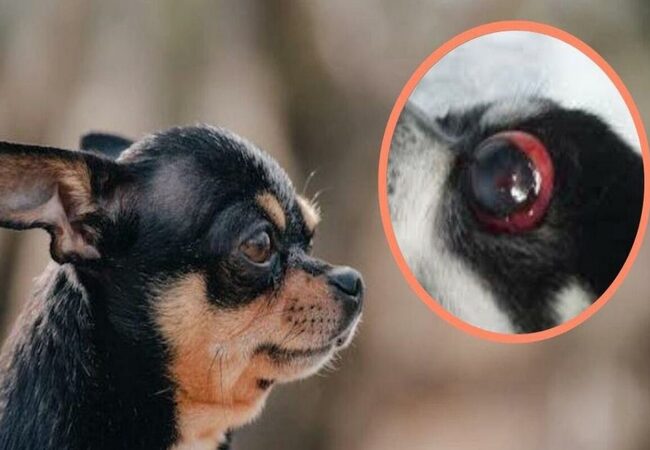🩺 Vet’s 2025 Guide to Canine Ocular Proptosis 🐶 Emergency Response, Treatment & Care

In this article
Vet’s 2025 Guide to Canine Ocular Proptosis 🐶 Emergency Treatment, Aftercare & Quality of Life
By Dr. Duncan Houston BVSc
💡 Introduction
Ocular proptosis is a critical emergency where a dog’s eyeball is forced forward out of the socket, commonly trapping the eyelids behind it and risking severe corneal damage. Immediate action is vital to save the eye and prevent blindness.
1. Causes & Risk Factors
- Trauma: Car collisions, dog fights, and blunt trauma are leading causes.
- Brachycephalic breeds: Pugs, Shih Tzus, Pekingese, Bulldogs have shallow orbits—eyes are exposed even to mild pressure (e.g., tight collars, scruffing).
- Neck pressure: Carrying by scruff or choke collars can precipitate proptosis in predisposed dogs.
2. Recognizing the Emergency
- Visible protrusion of the eye, eyelid trapped behind the globe.
- Signs of pain: whining, pawing at the eye, restlessness, territorial aggression.
- Redness, dry or ulcerated cornea, bleeding under eyelids.
- Possible nerve or muscle damage—the eye may hang loose or appear deflated.
3. Initial First Aid
- Keep the exposed eye moist with lubricating drops or saline-soaked gauze—avoid touching the eyeball.
- Apply an E-collar to prevent rubbing.
- Transport dog to the clinic immediately—time is critical.
4. Veterinary Evaluation & Diagnosis
- Confirm globe position, assess pupillary reflexes, and structural integrity.
- Check intraocular pressure (IOP) and evaluate for corneal ulceration.
- Assess extraocular muscles and optic nerve viability.
- Check for additional injuries—skull fractures, orbital hemorrhage—via CT/MRI if needed.
5. Treatment Options ❤️
5.1 Globe Replacement (Temporary Tarsorrhaphy)
- Reposition under general anesthesia; eyelids sutured closed (tarsorrhaphy) for 2–3 weeks.
- Administer painkillers, antibiotics, lubricants, plus anti-inflammatories.
- Prognosis: ~40% regain vision; better with intact reflexes, limited muscle damage, and prompt treatment.
5.2 Enucleation or Prosthetic Eye
- Indicated when globe is unsalvageable (optic nerve/muscle rupture, severe hemorrhage).
- Removal relieves pain and prevents ongoing complications—good quality of life post-op.
- Option for prosthesis to maintain cosmetic appearance—must be placed by ophthalmologist.
6. Prognosis & Outcome
- Better for brachycephalic breeds with less orbital damage and earlier intervention.
- Poor indicators: rupture of ≥2 extraocular muscles, nerve damage, optic nerve rupture, severe intraocular bleeding, and non-brachycephalic breeds.
- Common sequelae: chronic dry eye, corneal ulcers, vision loss, glaucoma—lifelong monitoring required.
7. Post‑operative Care
- Continue lubricants, pain meds, and antibiotics; manage IOP if needed.
- Keep E-collar on until sutures are removed (10–21 days).
- Avoid neck collars post-op—use harnesses to prevent re-proptosis.
- Recheck visits at 3 days, 2 weeks, and longer-term for IOP, cornea, and comfort.
8. Long‑Term Quality of Life
- Even blind dogs adapt—maintain safety with secure fences and safe surrounds.
- Manage chronic dry eye and the risk of ulcers with drops and regular check-ups.
- Apply sunscreen near eye, avoid irritants, and groom with care.
9. Prevention & Owner Education 🛡️
- Avoid chokers and scruffing, especially with brachycephalics.
- Use harnesses, supervise interactions with other dogs, and avoid rough play or unsafe environments.
- Consider prophylactic eyelid surgery (“lateral tarsorrhaphy”) in high-risk breeds to reduce future proptosis.
10. Ask A Vet Home Support 📱
- Track discomfort, lubrication schedules, IOP meds, healing alerts, and symptom updates.
- Upload photos of the affected eye, swelling, or discharge for remote review.
- Receive reminders for follow-ups, suture removal, and milestones in healing.
- Educational content: safe handling, signs of re-injury, chronic care instructions.
🔍 Key Takeaways
- Proptosis is a vision‑threatening emergency; early action and surgery are essential.
- Globe replacement offers the best chance of retaining the eye and some vision.
- Enucleation ensures comfort if the eye cannot be saved.
- Future risk is reduced via preventive surgery and careful handling.
- Lifelong eye care is vital to protect against complications.
- Ask A Vet supports owners through emergency recovery and chronic eye health.
🩺 Conclusion ❤️
Ocular proptosis demands rapid intervention to save the eye and welfare of the dog. With 2025’s standards—fast repositioning, expert surgical care, meticulous aftercare, and proactive prevention—many dogs thrive with one or both eyes intact and maintain comfort. Ask A Vet brings remote support, timely reminders, and trusted veterinary guidance through every step for peace of mind. 🐾✨
Dr Duncan Houston BVSc – committed to emergency ophthalmology, compassionate follow-through, and informed owner partnership.
Visit AskAVet.com and download the Ask A Vet app to track healing, medication schedules, and symptom alerts—helping you support your pup every blink of the way. ❤️






